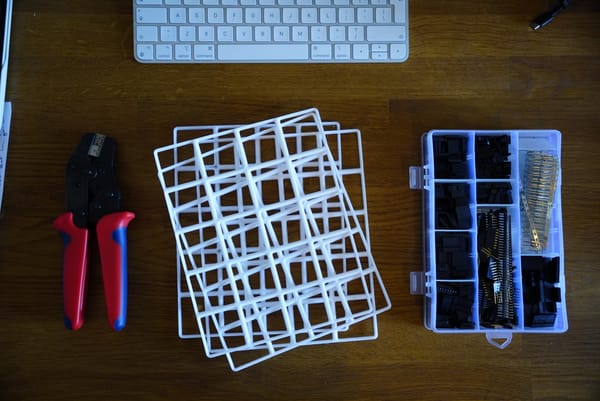Buy it for life - a story of 2 label printers

My buying philosophy has changed over time in no small part because of disappointments with products. These are my current thoughts on the matter, with a small use case. Hope you find this useful in your own buying decisions.
What stayed the same?
The frugality of pragmatism behind purchase decisions. I still ask myself things like
- Is this truly useful to you (or is it just FOMO)?
- What will you do with it afterwards? Is there any cost to maintenance/ storage/ disposal (including just the nuisance of it)?
- Is there a cheaper option that might give you the same benefit (e.g. off brand or something simpler that cuts from features you wouldn't use anyways)?
What changed in my purchase decisions?
First, the value I put on friction has changed a lot. Previously, I had a romantic view that I will use something, despite it being a bit awkward or unintuitive, in pursuit of keeping the price low.
Now, I have a far more realistic view of how things will go - if something is a nuisance to use, it will end up gathering dust in a corner. Thus...
Tools need to be delightful and almost encourage you to pick them up.
(bonus: minimal time/ steps between pick up and use - no complicated setup sequences, etc.)
Second, I'm less enchanted with my pursuit for a one-cable life via USB-C. Sure, it's a joy to have everything refuel with the same standard (especially in a world where most tools around require refuelling). However, recently, a few tools died on my because of poor circuitry that allowed their li-ion batteries to deplete during longer idle periods. The tools are perfectly fine, but they will never work again because the battery cannot be replaced. What a waste.
The alternative has not been great so far - mostly, leaning into AA and AAA (the old guard) which meant either a lot disposable batteries, or clunky chargers. Recently, I found a really good solution for this. You can actually get AA and AAA batteries (or other ones like the 9V one) with USB-C built into them! This is perfect. Thus, we can stick by this rule...
Consumables must be easy to replace - this incudes batteries.
(bonus: consumables should be cheap, reusable/ recyclable and user replaceable)
Third, I'm far less optimistic about physical products that replicate the micro service architecture that works so well with servers, and actively would advise against purchasing them. Let me explain.
You have a mobile phone in your pocket - why have another screen on most of your smart appliances, when all of that can be offloaded to your phone. Let the appliance or tool just focus on its core function and nothing else.
Sounds great but, unfortunately, it's not as easy as that. When your product/ tools are dependent on additional devices, the likelihood that something in the chain will break sooner or later is high. The app doesn't get updated to the latest iOS, or the company decides to shut down its servers, sever support for your version, etc.
This happens all the time, and perfectly good devices are bricked because companies decide to abandon them in favour for something else.
If/ when possible, the core functionality of the tool/ product/ appliance must not depend on successfully talking with other tools/ products in the ecosystem. In these cases, if the manufacturer/ vendor decides to stop maintaining their infrastructure tomorrow, the tool will continue to be valuable. Thus,
Tools must be stand-alone/ independent of apps, servers, subscription etc. where possible - all core features must be on device.
(bonus: simple interfaces that stood the test of time and the test of peers should be preferable to completely new sophisticated-on-the-surface heuristics with no track record)
(bonus2: the product/ tool should also ideally be independent of the manufacturer when it comes to repairs - a logical way into the product via visible screws is much preferable to impenetrable prisons of injection moulding and glue)
Case study - label makers
Since my business (and passion) crossed intellectual creativity (consulting) into practical creativity (physical designs, prototypes, art pieces), there are many things floating around the office.
Tools, sets, components, connectors, sketches, consumables, wires, bits of materials - they all need to be close, and all need to be well organisation to enable/ stimulate ingenuity (as opposed to suffocate it).
Labelling is essential towards this pursuit (David explains it really well in this video).
I already had a label maker that I never used. I bought a new one, and I suspect my organisation in BAU will improve.
First label maker (call it A): really cheap, small, USB-C chargeable, works solely with an app on the phone, technically more functionality.
Second label maker (call it B): really cheap, bulkier, AAA batteries, completely self-contained, technically less functionality.
Feels like a complete step backwards, doesn't it? Well, here are some arguments against that.
First, using the tool should be easy. Product A required me to make sure it's charged (if not, pause for 1 hour to charge it), turn it on and pair it with the phone's bluetooth, open the app (sometimes, redownload it), start fiddling with the label design, print it, long-press to turn the thing off.
The barrier to create the first label was between 20 seconds to 3 minutes for the simplest of tasks.
Product B requires me to turn it on (if nothing happens, quick swap AAA batteries), type out my label, print, quick turn off, done. It takes only 5-10 seconds!
Second, consumables should be cheap and easy to replace. Product A uses some weird chip inside their label rolls - this allows the product to recognise it, but you're not going to change it every day (thus this is useless to the user). Furthermore, the battery of Product A is baked in - there is no way to replace it.
Product B has loads of suppliers, cheaply producing label rolls for it. Furthermore, the batteries are a non issue - just replace it with a different set of AAAs.
Third, critical functionality should not be outsourced. Product A wholly depends on its app - there are no screens or interfaces to be able to create labels after the company decides to walk away from maintaining the app.
Product B has everything required built in - a screen and keyboard.
Are these are nice as the iPhone app? No. But they are always going to be there, in physical form (with the added benefit of the first argument - always there, without delay).
Will Product B still break? Sure - after all, it was quite cheap.
But it's unlikely it will because the manufacturer has decided to stop supporting it, or because my negligence means that the non-replaceable battery inside ran completely dead.
Conclusion
My criteria for buying products has shifted over the years. Here are some considerations worth keeping in mind for your next purchase:
- Product must be useful to you, truly - discount FOMO
- Product must fit with your environment - consider how you will use it, maintain it, store it, dispose of it
- Product must be cost optimised - consider alternatives that fulfil the same purpose, as well as initial investment + consumables/ ongoing costs
- Product must be delightful to use - it must invite you to interact with it
- Product must rely on easy to replace consumables - including its batteries
- Product must be stand-alone - all core features must be on device to ensure its longevity is not threatened by third parties
References
- The BuyItForLife Reddit, full of ideas and shared experiences
- Buy it for Life: Finding the Best Products in the World - a fun website with a cost calculator for lifetime value
- Products That Are Built To Last – Buy Me Once UK - another fun website with a marketplace




